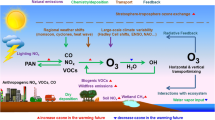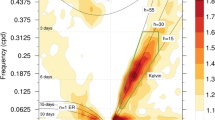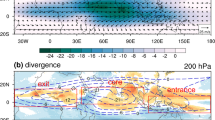Abstract
Closure assumption in convection parameterization is critical for reasonably modeling the precipitation diurnal variation in climate models. This study evaluates the precipitation diurnal cycles over East Asia during the summer of 2008 simulated with three convective available potential energy (CAPE) based closure assumptions, i.e. CAPE-relaxing (CR), quasi-equilibrium (QE), and free-troposphere QE (FTQE) and investigates the impacts of planetary boundary layer (PBL) mixing, advection, and radiation on the simulation by using the weather research and forecasting model. The sensitivity of precipitation diurnal cycle to PBL vertical resolution is also examined. Results show that the precipitation diurnal cycles simulated with different closures all exhibit large biases over land and the simulation with FTQE closure agrees best with observation. In the simulation with QE closure, the intensified PBL mixing after sunrise is responsible for the late-morning peak of convective precipitation, while in the simulation with FTQE closure, convective precipitation is mainly controlled by advection cooling. The relative contributions of different processes to precipitation formation are functions of rainfall intensity. In the simulation with CR closure, the dynamical equilibrium in the free troposphere still can be reached, implying the complex cause-effect relationship between atmospheric motion and convection. For simulations in which total CAPE is consumed for the closures, daytime precipitation decreases with increased PBL resolution because thinner model layer produces lower convection starting layer, leading to stronger downdraft cooling and CAPE consumption. The sensitivity of the diurnal peak time of precipitation to closure assumption can also be modulated by changes in PBL vertical resolution. The results of this study help us better understand the impacts of various processes on the precipitation diurnal cycle simulation.















Similar content being viewed by others
References
Arakawa A (2004) The cumulus parameterization problem: past, present, and future. J Clim 17:2493–2525
Arakawa A, Schubert WH (1974) Interaction of a cumulus cloud ensemble with large-scale environment, part I. J Atmos Sci 31:674–701
Bao Q, Lin PF, Zhou TJ, Liu YM, Yu YQ, Wu GX, He B, He J, Li LJ, Li JD, Li YC, Liu HL, Qiao FL, Song ZY, Wang B, Wang J, Wang PF, Wang XC, Wang ZZ, Wu B, Wu TW, Xu YF, Yu HY, Zhao W, Zheng WP, Zhou LJ (2013) The flexible global ocean-atmosphere-land system model, spectral version 2: FGOALS-s2. Adv Atmos Sci 30:561–576. doi:10.1007/s00376-012-2113-9
Barker HW, Pincus R, Morcrette J-J (2003) The Monte-Carlo independent column approximation: application within largescale models. In: Proceedings of the GCSS/ARM Workshop on the Representation of Cloud Systems in Large-Scale Models, May 2002, Kananaskis, Alberta, Canada, p 10
Bechtold P, Semane N, Lopez P, Chaboureau J-P, Beljaars A, Bormann N (2014) Representing equilibrium and nonequilibrium convection in large-scale models. J Atmos Sci 71:734–753. doi:10.1175/jas-d-13-0163.1
Bretherton CS, Park S (2009) A new moist turbulence parameterization in the community atmosphere model. J Clim 22:3422–3448. doi:10.1175/2008jcli2556.1
Brown JM (1979) Mesoscale unsaturated downdrafts driven by rainfall evaporation: numerical study. J Atmos Sci 36:313–338. doi:10.1175/1520-0469(1979)036<0313:Muddbr>2.0.Co;2
Cha DH, Lee DK, Hong SY (2008) Impact of boundary layer processes on seasonal simulation of the East Asian summer monsoon using a Regional Climate Model. Meteorol Atmos Phys 100:53–72. doi:10.1007/s00703-008-0295-6
Chen F, Dudhia J (2001) Coupling an advanced land surface-hydrology model with the Penn State-NCAR MM5 modeling system. Part I: model implementation and sensitivity. Mon Weather Rev 129:569–585
Chen S et al (2016) Precipitation spectra analysis over china with high-resolution measurements from optimally-merged satellite/gauge observations-part II: diurnal variability analysis. IEEE J Stars 9:2979–2988. doi:10.1109/JSTARS.2016.2529001
Dai A (1999) Recent changes in the diurnal cycle of precipitation over the United States. Geophys Res Lett 26:341–344. doi:10.1029/1998gl900318
Dai A, Trenberth KE (2004) The diurnal cycle and its depiction in the Community Climate System Model. J Clim 17:930–951. doi:10.1175/1520-0442(2004)017<0930:Tdcaid>2.0.Co;2
Donner LJ, Phillips VT (2003) Boundary layer control on convective available potential energy: implications for cumulus parameterization. J Geophys Res. doi:10.1029/2003jd003773
Emanuel KA (1995) The behavior of a simple hurricane model using a convective scheme based on subcloud-layer entropy equilibrium. J Atmos Sci 52:3960–3968. doi:10.1175/1520-0469(1995)052<3960:Tboash>2.0.Co;2
Frank WM, Cohen C (1987) Simulation of tropical convective systems 0.1. A cumulus parameterization. J Atmos Sci 44:3787–3799. doi:10.1175/1520-0469(1987)044<3787:Sotcsp>2.0.Co;2
Grell GA (1993) Prognostic evaluation of assumptions used by cumulus parameterizations. Mon Weather Rev 121:764–787. doi:10.1175/1520-0493(1993)121<0764:Peoaub>2.0.Co;2
He HZ, Zhang FQ (2010) Diurnal variations of warm-season precipitation over Northern China. Mon Weather Rev 138:1017–1025. doi:10.1175/2010MWR3356.1
Huang A, Zhao Y, Zhou Y, Yang B, Zhang L, Dong X, Fang D, Wu Y (2016) Evaluation of multisatellite precipitation products by use of ground-based data over China. J Geophys Res Atmos 121:10654–10675. doi:10.1002/2016jd025456
Huffman GJ, Adler RF, Morrissey MM, Bolvin DT, Curtis S, Joyce R, McGavock B, Susskind J (2001) Global precipitation at one-degree daily resolution from multisatellite observations. J Hydrometeorol 2:36–50
Huffman GJ, Adler RF, Bolvin DT, Gu GJ, Nelkin EJ, Bowman KP, Hong Y, Stocker EF, Wolff DB (2007) The TRMM multisatellite precipitation analysis (TMPA): Quasi-global, multiyear, combined-sensor precipitation estimates at fine scales. J Hydrometeorol 8:38–55. doi:10.1175/Jhm560.1
Janjić ZI (1994) The step-mountain eta coordinate model—further developments of the convection, viscous sublayer, and turbulence closure schemes. Mon Weather Rev 122:927–945
Janjić ZI (2002) Nonsingular implementation of the Mellor–Yamada level 2.5 scheme in the NCEP Meso model. NCEP office note 437:61
Ji D, Wang L, Feng J, Wu Q, Cheng H, Zhang Q, Yang J, Dong W, Dai Y, Gong D, Zhang RH, Wang X, Liu J, Moore JC, Chen D, Zhou M (2014) Description and basic evaluation of Beijing Normal University Earth System Model (BNU-ESM) version 1. Geosci Model Dev 7:2039–2064. doi:10.5194/gmd-7-2039-2014
Jin EK, Choi I-J, Kim S-Y, Han J-Y (2016) Impact of model resolution on the simulation of diurnal variations of precipitation over East Asia. J Geophys Res Atmos 121:1652–1670. doi:10.1002/2015jd023948
Kain JS (2004) The Kain–Fritsch convective parameterization: an update. J Appl Meteorol 43:170–181
Kain JS, Fritsch JM (1993) Convective parameterization for mesoscale models: the Kain–Fritcsh scheme. In: Emanuel KA, Raymond DJ (eds) The representation of cumulus convection in numerical models. American Meteorology Society, Boston, p 246
Kozu T, Kawanishi T, Kuroiwa H, Kojima M, Oikawa K, Kumagai H, Okamoto K, Okumua M, Nakatsuka H, Nishikawa K (2001) Development of precipitation radar onboard the Tropical Rainfall Measuring Mission (TRMM) satellite. IEEE Trans Geosci Remote 39:102–116
Krishnamurti TN, Lownam S, Pasch R (1983) Cumulus parameterization and rainfall rates II. Mon Weather Rev 111:815–828. doi:10.1175/1520-0493(1983)111<0815:Cparri>2.0.Co;2
Lee MI, Schubert SD, Suarez MJ, Schemm J-KE, Pan H-L, Han J, Yoo S-H (2008) Role of convection triggers in the simulation of the diurnal cycle of precipitation over the United States Great Plains in a general circulation model. J Geophys Res. doi:10.1029/2007jd008984
Leung LR, Ghan SJ, Zhao ZC, Luo Y, Wang WC, Wei HL (1999) Intercomparison of regional climate simulations of the 1991 summer monsoon in eastern Asia. J Geophys Res 104:6425–6454. doi:10.1029/1998jd200016
Li J, Yu RC, Zhou TJ (2008) Seasonal variation of the diurnal cycle of rainfall in southern contiguous China. J Clim 21:6036–6043. doi:10.1175/2008JCLI2188.1
Liang XZ, Li L, Dai A, Kunkel KE (2004) Regional climate model simulation of summer precipitation diurnal cycle over the United States. Geophys Res Lett 31:L24208. doi:10.1029/2004GL021054
Ma PL, Rasch PJ, Fast JD, Easter RC, Gustafson WI Jr, Liu X, Ghan SJ, Singh B (2014) Assessing the CAM5 physics suite in the WRF-Chem model: implementation, resolution sensitivity, and a first evaluation for a regional case study. Geosci Model Dev 7:755–778. doi:10.5194/gmd-7-755-2014
Morrison H, Curry JA, Khvorostyanov VI (2005) A new double-moment microphysics parameterization for application in cloud and climate models. Part I: description. J Atmos Sci 62:1665–1677
Neale RB, Richter JH, Jochum M (2008) The impact of convection on ENSO: from a delayed oscillator to a series of events. J Clim 21:5904–5924. doi:10.1175/2008jcli2244.1
Park S, Bretherton CS (2009) The University of Washington shallow convection and moist turbulence schemes and their impact on climate simulations with the community atmosphere model. J Clim 22:3449–3469. doi:10.1175/2008jcli2557.1
Pincus R, Barker HW, Morcrette JJ (2003) A fast, flexible, approximate technique for computing radiative transfer in inhomogeneous cloud fields. J Geophys Res 108:4376. doi:10.1029/2002JD003322
Qian Y, Leung LR (2007) A long-term regional simulation and observations of the hydroclimate in China. J Geophys Res 112:D14104. doi:10.1029/2006jd008134
Qian Y, Yan H, Hou Z, Johannesson G, Klein S, Lucas D, Neale R, Rasch P, Swiler L, Tannahill J, Wang H, Wang M, Zhao C (2015) Parametric sensitivity analysis of precipitation at global and local scales in the Community Atmosphere Model CAM5. J Adv Model Earth Syst 7:382–411. doi:10.1002/2014ms000354
Qiao FX, Liang XZ (2015) Effects of cumulus parameterizations on predictions of summer flood in the Central United States. Clim Dyn 45:727–744. doi:10.1007/s00382-014-2301-7
Qiao FX, Liang XZ (2016) Effects of cumulus parameterization closures on simulations of summer precipitation over the United States coastal oceans. J Adv Model Earth Syst 8:764–785. doi:10.1002/2015MS000621
Raymond DJ (1995) Regulation of moist convection over the West Pacific warm pool. J Atmos Sci 52:3945–3959. doi:10.1175/1520-0469(1995)052<3945:Romcot>2.0.Co;2
Schumacher C, Houze RA (2003) Stratiform rain in the tropics as seen by the TRMM precipitation radar. J Clim 16:1739–1756
Skamarock WC, Klemp JB, Dudhia J, Gill DO, Barker DM, Duda MG, Huang X-Y, Wang W, Powers JG (2008) A description of the advanced research WRF Version 3. NCAR Technical Note, NCAR/TN-475+STR
Suhas E, Zhang GJ (2014) Evaluation of trigger functions for convective parameterization schemes using observations. J Clim 27:7647–7666. doi:10.1175/jcli-d-13-00718.1
Suhas E, Zhang GJ (2015) Evaluating convective parameterization closures using cloud-resolving model simulation of tropical deep convection. J Geophys Res Atmos 120:1260–1277. doi:10.1002/2014jd022246
Wu TW (2012) A mass-flux cumulus parameterization scheme for large-scale models: description and test with observations. Clim Dyn 38:725–744. doi:10.1007/s00382-011-0995-3
Wu TW, Yu RC, Zhang F, Wang ZZ, Dong M, Wang LN, Jin X, Chen DL, Li L (2010) The Beijing Climate Center atmospheric general circulation model: description and its performance for the present-day climate. Clim Dyn 34:123–147. doi:10.1007/s00382-008-0487-2
Wu CM, Lo MH, Chen WT, Lu CT (2015) The impacts of heterogeneous land surface fluxes on the diurnal cycle precipitation: a framework for improving the GCM representation of land–atmosphere interactions. J Geophys Res 120:3714–3727. doi:10.1002/2014JD023030
Yang B, Qian Y, Lin G, Leung LR, Zhang Y (2012) Some issues in uncertainty quantification and parameter tuning: a case study of convective parameterization scheme in the WRF regional climate model. Atmos Chem Phys 12:2409–2427. doi:10.5194/acp-12-2409-2012
Yang B, Qian Y, Lin G, Leung LR, Rasch PJ, Zhang GJ, McFarlane SA, Zhao C, Zhang Y, Wang H, Wang M, Liu X (2013) Uncertainty quantification and parameter tuning in the CAM5 Zhang–McFarlane convection scheme and impact of improved convection on the global circulation and climate. J Geophys Res Atmos 118:395–415. doi:10.1029/2012jd018213
Yang B, Zhang Y, Qian Y, Huang A, Yan H (2015a) Calibration of a convective parameterization scheme in the WRF model and its impact on the simulation of East Asian summer monsoon precipitation. Clim Dyn 44:1661–1684. doi:10.1007/s00382-014-2118-4
Yang B, Zhang Y, Qian Y, Wu T, Huang A, Fang Y (2015b) Parametric sensitivity analysis for the Asian summer monsoon precipitation simulation in the beijing climate center AGCM, Version 2.1. J Clim 28:5622–5644. doi:10.1175/jcli-d-14-00655.1
Yano JI, Bister M, Fuchs Ž, Gerard L, Phillips VTJ, Barkidija S, Piriou JM (2013) Phenomenology of convection-parameterization closure. Atmos Chem Phys 13:4111–4131. doi:10.5194/acp-13-4111-2013
Yu RC, Zhou TJ, Xiong AY, Zhu YJ, Li JM (2007) Diurnal variations of summer precipitation over contiguous China. Geophys Res Lett 34:L01704. doi:10.1029/2006gl028129
Yuan W (2013) Diurnal cycles of precipitation over subtropical China in IPCC AR5 AMIP simulations. Adv Atmos Sci 30:1679–1694. doi:10.1007/s00376-013-2250-9
Yuan W, Yu R, Li J (2013) Changes in the diurnal cycles of precipitation over eastern China in the past 40 years. Adv Atmos Sci 30:461–467. doi:10.1007/s00376-012-2092-x
Zhang GJ (2002) Convective quasi-equilibrium in midlatitude continental environment and its effect on convective parameterization. J Geophys Res. doi:10.1029/2001jd001005
Zhang GJ (2009) Effects of entrainment on convective available potential energy and closure assumptions in convection parameterization. J Geophys Res 114:D07109. doi:10.1029/2008jd010976
Zhang Y, Chen H (2016) Comparing CAM5 and superparameterized CAM5 simulations of summer precipitation characteristics over continental East Asia: mean state, frequency–intensity relationship, diurnal cycle, and influencing factors. J Clim 29:1067–1089. doi:10.1175/jcli-d-15-0342.1
Zhang GJ, Mcfarlane NA (1995) Sensitivity of climate simulations to the parameterization of cumulus convection in the Canadian climate center general-circulation model. Atmos Ocean 33:407–446
Zhou TJ, Yu RC, Chen HM, Dai A, Pan Y (2008) Summer precipitation frequency, intensity, and diurnal cycle over China: a comparison of satellite data with rain gauge observations. J Clim 21:3997–4010. doi:10.1175/2008JCLI2028.1
Acknowledgements
We thank two anonymous reviewers for their careful reviews and constructive comments. We also thank Minghuai Wang of Nanjing University for his valuable discussions and Jian Tang of China Meteorological Administration for processing the station rain-gauge data. This work is jointly supported by the National Natural Science Foundation of China (41675101 and 41305084) and National key research and development program (2016YFA0602104 and 2016YFA0600504). The contribution of Yun Qian in this study is supported by the U.S. Department of Energy’s Office of Science as part of the Atmospheric System Research (ASR) program. The Pacific Northwest National Laboratory is operated for DOE by Battelle Memorial Institute under contract DE-AC05-76RL01830. All the graphics in this study are created by the NCAR Command Language (NCL; doi:10.5065/D6WD3XH5).
Author information
Authors and Affiliations
Corresponding author
Rights and permissions
About this article
Cite this article
Yang, B., Zhou, Y., Zhang, Y. et al. Simulated precipitation diurnal cycles over East Asia using different CAPE-based convective closure schemes in WRF model. Clim Dyn 50, 1639–1658 (2018). https://doi.org/10.1007/s00382-017-3712-z
Received:
Accepted:
Published:
Issue Date:
DOI: https://doi.org/10.1007/s00382-017-3712-z




